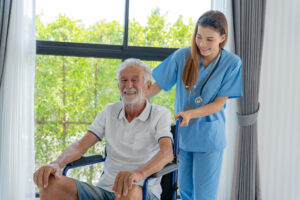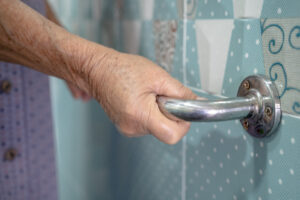
Most seniors want to age at home. Forbes Health states that 92% of older adults want to
stay at home. Through thoughtful planning, discussions with family, and active research
into available resources, aging in place at home can be an attainable option.
Is there a formula to successfully age in place? For those who want to stay in their own
home safely, the strategy must include a solid aging plan with three core components.
Whether your aging loved one lives alone or in a multi-generational home, this strategy
can be a game-changer.
3 Step Formula for Success
1. Home care
2. Home modifications
3. Assistive technology

1. Accepting help in the home is key to success.
We all want to be independent. For an older adult, they can’t remember a time when they
needed help with the basic tasks of life such as bathing, grooming, and dressing. Often,
they don’t view themselves as needing help so they refuse services that can reduce the
risk of injury. However, for this strategy to work, accepting help in the home is non-
negotiable.
A significant aspect of aging safely is the willingness to be proactive. The senior and family
that identifies challenges and addresses them early is most likely to avoid significant
issues later. Unsteadiness comes before a stumble and a stumble comes before a fall. Why
wouldn’t we want to address the unsteadiness instead of recovering from the injuries of a
fall?
What is Home Care?
Home care can provide a variety of non-medical caregiving and assistance in the home.
From meal preparation to light housekeeping to hands-on help with bathing, grooming,
and dressing, a home caregiver is a significant factor in successfully aging at home.
Whether your aging parent is living at home alone or is living with you, a private caregiver
that focuses on the specific needs of the senior is a proactive step. Ultimately, the
caregiver can be the difference between staying at home and moving to senior living.
Strategic Services for Success
Meal preparation
Activities of daily living
Transportation
Companionship
Seniors can get exhausted with the basic tasks of daily life. Even the process of preparing
meals can become too much, resulting in skipped meals and poor food choices. Good
nutrition is foundational for healthy living. Simply getting help with meal preparation can
make a difference for the senior set on staying at home.

2. Plan for home modifications as needs change.
We all want our forever home. And aging loved ones are no different. As needs change, the
home will need modifications – no question. Some home modifications are simple and
inexpensive while larger projects can take time and money. By making the smaller changes
early and easing into the expense of larger projects, you can continue to monitor the value
of staying at home compared to senior living and adjust your aging plan accordingly.
Common Home Modifications
Grab bars
Widen doors
Ramps
Curb-less shower
Walk-in tub
Stairlift
Rearranging furniture and removing trip hazards such as throw rugs are a proactive start
to making a home senior-friendly. From easy-grip knobs and pulls to adjustable hand-held
shower heads, it's easy to add inexpensive conveniences into the home without breaking
the bank. When it comes time to reimagine the floorplan of a two-story home to main
floor living, it’s no secret – be sure to review the aging plan for financial feasibility.
How Do I Pay for Home Modifications?
The costs of creating a home for aging in place can vary greatly. Home modifications that
involve structural changes such as an accessible kitchen or relocating a primary suite to a
ground floor will be expensive. The savvy senior and their family have considered the cost
of these renovations in their aging plan and are prepared to pay for reasonable home
renovations.
Paying for Home Modifications
Home Equity Line of Credit
Home equity loan
Personal loan
If you are worried about home modifications affecting property value, keep the changes
fashionable. Homeowners are looking for over-sized curb-less showers, remote-controlled
window shades, and other stylish changes. Consult with designers that can help you
create modifications that appeal to all ages rather than scream “age in place.”

3. Assistive technology is a smart solution for aging in place.
Smart systems are here to stay and families with aging parents can reap the benefits! In
addition to home modifications like remote-controlled window shades and home security
systems, non-permanent assistive technology helps families stay connected in a way that
can significantly extend an aging parent’s stay at home. These assistive devices round out
a strong strategy to assist a senior in aging in place safely at home.
Assistive Technology for Seniors
Hero Health pill minder
Zoom, Skype
Alexa
Google Home
Whether you live across the country, across town, or in the same home as an aging parent,
assistive technology can help you keep an eye on the home front without compromising
dignity or PTO time. You can monitor home temperatures, who’s at the front door, and
what groceries are in the fridge with a tap on an app.
It’s time to make friends with all the devices. Sure, Alexa may be eavesdropping on all your
conversations but she’s paying attention when your loved one says, “Alexa, call my
daughter” if there is an emergency. Take away the distance between (great)grandparents
and their offspring with Zoom calls and smart digital photo frames.

Plan and Prepare for Aging at Home
This three-step strategy isn’t a sure thing for all seniors. For example, resources will be
more available in an urban area where a rural area may be sparse in support. Above all,
this strategy works best with the proper preparation provided in an aging plan. It is never
too early to start creating a plan that keeps you in your home with the assistance of home
care, home modifications, and assistive technology.
For more information on how private duty home care can help seniors age in place,
contact Champion Home Health Care in Brevard County, Florida (321) 608 – 3838.




